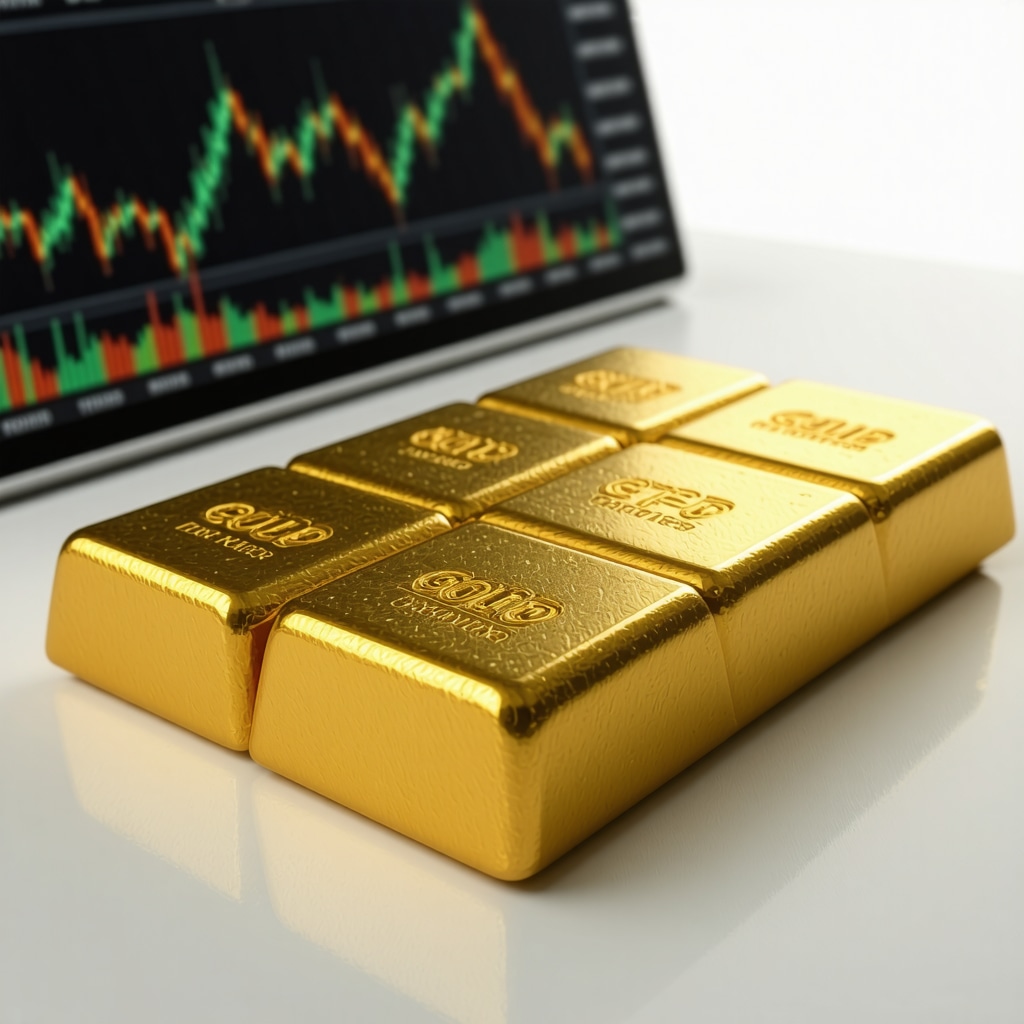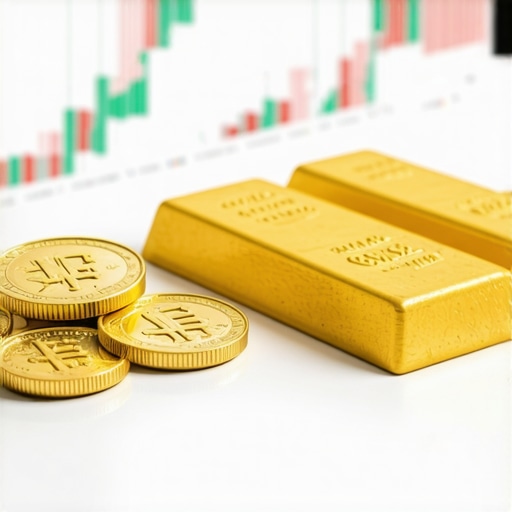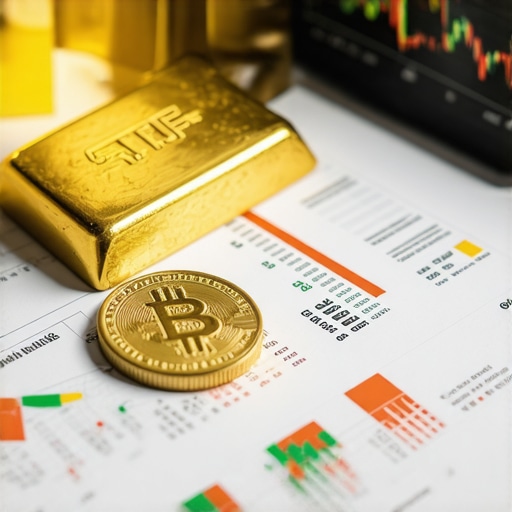Unlocking the Golden Triad: Futures, ETFs, and Bars
Gold has long been revered as a sanctuary asset in times of economic uncertainty and inflationary pressures. Yet, the pathways to investing in gold are as diverse as the metal’s storied history. Whether you are a seasoned investor or a newcomer, understanding the nuances between gold futures, ETFs, and physical bars is crucial to crafting a portfolio that balances risk, liquidity, and long-term value.
Futures: The High-Stakes Arena of Gold Trading
Gold futures contracts represent agreements to buy or sell gold at a predetermined price on a specific future date. This financial instrument is favored by traders looking to speculate on price movements and hedge against market volatility. The leverage involved can amplify gains but equally magnify losses, making it an arena best suited for those with a robust risk appetite and comprehensive market knowledge.
For example, professional traders often utilize futures to capitalize on short-term price swings driven by geopolitical events or shifts in central bank policies. The Chicago Mercantile Exchange (CME) is a leading platform offering gold futures, providing liquidity and standardized contracts that facilitate sophisticated trading strategies. If you’re curious about diving deeper into this field, resources like Understanding Gold Futures: A Guide for New Investors in 2029 offer invaluable insights.
ETFs: The Seamless Gateway to Gold Exposure
Exchange-Traded Funds (ETFs) backed by gold provide a convenient and cost-effective way to gain exposure without handling physical metal. These funds typically hold physical gold or gold futures contracts, and their shares trade on stock exchanges just like other equities. ETFs offer high liquidity, ease of trading, and diversification, making them a popular choice for investors seeking to integrate gold into their portfolios alongside stocks and bonds.
One must consider, however, the management fees and the underlying asset structure when selecting gold ETFs. For a detailed comparison of top-performing ETFs and mutual funds that enhance portfolio diversification, see Best Gold ETFs and Mutual Funds for Portfolio Diversification.
Bars: Tangible Wealth with Timeless Appeal
Investing in physical gold bars offers a direct ownership experience and a hedge against systemic risks inherent in financial markets. Bars vary in size and purity, with well-recognized brands and certifications enhancing liquidity and trustworthiness. While physical gold requires secure storage and insurance, it provides a form of wealth preservation that is impervious to digital asset failures or institutional defaults.
Seasoned investors often emphasize the importance of authenticity and provenance. Guides such as Physical Gold Investment Checklist: What to Know Before Buying outline critical considerations to avoid scams and ensure genuine ownership.
What Factors Should Guide Your Choice Among Gold Futures, ETFs, and Bars?
Choosing between gold futures, ETFs, and bars depends heavily on your investment goals, risk tolerance, and liquidity needs. Futures offer high leverage and potential for quick gains but demand active management and risk discipline. ETFs provide a balanced approach with ease of trading and portfolio integration, suited for both passive and active investors. Physical bars appeal to those prioritizing tangible assets, long-term security, and control over their investment.
For instance, if market volatility is your playground and you possess advanced trading skills, futures trading might align with your strategy. Conversely, if you prefer a hands-off investment with transparent pricing and daily liquidity, ETFs are attractive. Meanwhile, physical gold suits investors seeking to diversify away from financial systems and safeguard assets against currency devaluation.
Expert investors often blend these types to optimize risk and return dynamics. This multi-dimensional approach is discussed further in Types of Gold Investments: Which Suits Your Strategy Best in 2028.
Exploring these options equips you with the knowledge to tailor your gold investments to your financial landscape and aspirations.
Ready to deepen your investment strategy? Share your thoughts or questions below and join the conversation on mastering gold investments.
For authoritative perspectives on gold’s role in economic security and investment planning, the World Gold Council provides extensive research and market analysis that can enrich your understanding (World Gold Council).
Balancing Act: Diversification Across Gold Investment Types
Reflecting on my own journey, I found that blending gold futures, ETFs, and physical bars often creates a more resilient portfolio than relying on just one. For example, when I started with futures trading, the adrenaline of leveraging price moves was addictive, but I quickly realized it required constant attention and a solid grasp of market dynamics. That’s when I integrated ETFs — a more hands-off yet liquid option — to balance my exposure while maintaining flexibility.
Physical gold bars, on the other hand, became my anchor during uncertain times. I vividly recall the peace of mind I felt holding tangible assets amid digital market turbulence. There’s something inherently reassuring about that weight in your hand — a timeless store of value that no algorithm can erase.
The Role of Central Banks: A Hidden Influence on Gold Prices
One aspect that intrigued me deeply is how central bank gold purchases shape global supply and prices. Watching news about central banks increasing their gold reserves made me realize that these moves often signal broader economic sentiments and can impact price trends significantly.
According to the World Gold Council, central bank buying accounted for a substantial portion of demand in recent years, influencing market liquidity and investor confidence. This insight helped me appreciate why staying informed about macroeconomic factors is essential, especially when engaging with gold futures or ETFs that are sensitive to such shifts.
When Does Gold Make Sense in Your Portfolio?
Are You Aligning Your Gold Investment with Your Financial Goals and Risk Appetite?
This question became a personal reflection point as I balanced the allure of gold with my broader investment strategy. Gold’s role as a hedge against inflation and currency devaluation is well documented, but how it fits depends on your unique circumstances.
If you prioritize capital preservation and want a tangible asset, physical gold bars might be your best bet. For those seeking to complement equities with a liquid, diversifying asset, ETFs offer an efficient solution. And for the risk-tolerant, futures trading can be an exciting way to leverage market movements, but only with disciplined risk management.
Exploring more about how different gold investment strategies can optimize returns amidst market volatility is enlightening. For a comprehensive dive, Comprehensive Guide to Gold Investment Strategies for Market Volatility offers valuable perspectives.
Have you experimented with mixing gold investment types? What has worked best for your risk tolerance and financial aspirations? Feel free to share your experiences or questions below — let’s learn from each other’s journeys.
Decoding Macroeconomic Signals: How Global Events Shape Gold’s Trajectory
Gold’s price dynamics are intricately tied to a web of macroeconomic variables, geopolitical tensions, and monetary policies. Seasoned investors recognize that beyond technical charts and market sentiment, understanding the subtle interplay of these forces is pivotal. For instance, inflation expectations, real interest rates, and currency fluctuations often serve as precursors to shifts in gold valuations.
Take, for example, the inverse relationship between real yields on government bonds and gold prices: when real yields decline, gold becomes more attractive as a non-yielding asset, often propelling its price upward. Moreover, political instability or trade disputes can trigger safe-haven demand, amplifying gold’s allure. This nuanced comprehension enables investors to anticipate and strategically position themselves ahead of market moves rather than merely reacting.
How Can Sophisticated Investors Utilize Central Bank Policies to Forecast Gold Price Movements?
Central banks wield substantial influence over gold markets through their reserve management strategies. By monitoring central bank disclosures and global monetary policy shifts, investors can glean insights into potential supply-demand imbalances. For example, a sustained increase in gold reserves by emerging market central banks often signals a strategic pivot away from fiat currencies, potentially foreshadowing upward price pressure.
Beyond mere observation, advanced investors integrate these signals with derivative market data, such as futures open interest and options skew, to construct probabilistic forecasts. Combining fundamental analysis with technical indicators creates a robust framework for decision-making, enhancing timing precision and risk mitigation.
Portfolio Optimization Techniques: Synergizing Gold Futures, ETFs, and Physical Bars
Maximizing gold’s role within a diversified portfolio demands more than just allocation—it requires strategic synergy between its various investment vehicles. Futures contracts offer tactical agility, allowing for leveraged exposure and hedging against transient market shocks. ETFs provide scalable, cost-efficient access with daily liquidity, facilitating dynamic rebalancing aligned with equity and bond cycles. Physical bars, conversely, deliver a durable store of value, impervious to counterparty risk and digital vulnerabilities.
Implementing multi-asset gold strategies involves calibrating exposure levels to align with an investor’s risk profile and market outlook. For instance, during anticipated inflation surges, increasing physical holdings may shield purchasing power, while tactical futures positions can exploit short-term volatility. Simultaneously, maintaining a core ETF allocation ensures portfolio liquidity and cost efficiency.
In practice, this approach demands ongoing portfolio stress testing and scenario analysis to measure sensitivity to gold price shocks and macroeconomic changes. Employing sophisticated software tools and consulting comprehensive reports—such as those from the World Gold Council’s research division—can significantly enhance strategic refinement.
Mitigating Risks in Gold Investments: Navigating Market Complexity and Operational Challenges
While gold offers unique hedging properties, it is not without risks that sophisticated investors must vigilantly manage. Futures trading entails margin requirements and liquidity risks, particularly during market stress. ETFs, though liquid, carry counterparty and tracking errors that can erode returns subtly over time. Physical gold confronts logistical challenges, including secure storage, insurance costs, and potential liquidity constraints during crises.
Advanced risk mitigation techniques encompass leveraging derivatives for hedging, diversifying across gold investment vehicles, and employing robust due diligence on custodians and counterparties. Furthermore, tax considerations and regulatory environments vary globally, necessitating tailored strategies per jurisdiction to optimize net returns.
Staying abreast of evolving market infrastructure and regulatory reforms is critical. Engaging with expert advisory forums and subscribing to specialized intelligence platforms can provide early warnings and actionable insights.
Are you ready to elevate your gold investment approach by integrating multifaceted strategies and market intelligence? Dive deeper into these advanced tactics and share your experiences to foster a community of informed investors.
Harnessing Global Macro Trends: A Strategic Edge for Gold Investors
In the labyrinth of global finance, gold’s trajectory is profoundly influenced by macroeconomic undercurrents that extend beyond conventional market analysis. Seasoned investors delve into real-time data on inflation trajectories, geopolitical risk indices, and currency reserve shifts to anticipate gold price inflections. These variables often precede market moves, offering a predictive vantage point that can substantially enhance timing and allocation strategies.
Moreover, integrating insights from cross-asset correlations—such as the interplay between gold and emerging market currencies or sovereign debt yields—enables a sophisticated understanding of systemic risks and opportunities. This multi-layered approach transcends simplistic bullish or bearish outlooks, empowering investors to calibrate exposure dynamically and harness gold’s unique hedging capabilities within diversified portfolios.
Decoding Sophisticated Hedging: The Intersection of Derivatives and Physical Gold
Advanced portfolio architects often exploit the complementary strengths of gold derivatives and physical holdings to construct resilient investment frameworks. For instance, tactical utilization of options strategies—like protective puts or covered calls on gold futures—can mitigate downside risks while preserving upside potential amidst volatile environments.
Simultaneously, maintaining a calibrated physical gold reserve serves as a tangible safeguard against systemic counterparty failures and digital market disruptions. This dual-layered strategy not only diversifies risk but also enhances liquidity management and capital efficiency, particularly during periods of acute market stress.
How Can Investors Quantitatively Assess Optimal Allocation Between Gold Futures, ETFs, and Physical Bars?
Determining the ideal mix demands rigorous quantitative modeling incorporating factors such as expected returns, volatility, liquidity constraints, and tail risk scenarios. Techniques like mean-variance optimization, supplemented with Monte Carlo simulations and stress-testing under macroeconomic shock assumptions, provide granular insights into portfolio robustness.
Furthermore, incorporating scenario analysis reflecting central bank policy shifts or geopolitical upheavals refines allocation decisions, ensuring adaptability to evolving market regimes. Investors leveraging advanced analytics platforms—often integrating data from authoritative sources like the World Gold Council’s Research Division—can systematically optimize their gold exposure, balancing growth and preservation objectives.
Operational Excellence: Navigating Custody, Compliance, and Market Infrastructure
Beyond strategic allocation, operational rigor is paramount in safeguarding gold investments. Selecting reputable custodians with transparent audit trails and insured storage solutions mitigates risks inherent in physical gold holdings. Equally, comprehending the nuances of ETF structures—such as authorized participant mechanisms and underlying asset liquidity—prevents inadvertent exposure to systemic vulnerabilities.
Regulatory compliance, including adherence to anti-money laundering protocols and tax optimization strategies, further fortifies the investment process. Staying abreast of evolving legal frameworks and market infrastructure innovations enables investors to preempt operational pitfalls and capitalize on emerging opportunities.

Engage with Expert Strategies: Elevate Your Gold Investment Portfolio
Integrating multifaceted gold investment vehicles with advanced macroeconomic insights and operational best practices unlocks superior portfolio resilience and performance potential. We invite you to delve deeper into these sophisticated methodologies and contribute your perspectives. How have you navigated the complexities of gold investment across futures, ETFs, and physical holdings? Share your experiences and questions to enrich our collective expertise.
Frequently Asked Questions (FAQ)
What are the primary differences between gold futures, ETFs, and physical gold bars?
Gold futures are leveraged contracts allowing investors to speculate or hedge on gold price movements with fixed settlement dates, suitable for active traders with high risk tolerance. ETFs offer liquid, cost-efficient exposure to gold prices by holding physical gold or futures contracts, ideal for investors seeking portfolio diversification with ease of trading. Physical gold bars represent direct ownership of tangible metal, providing a hedge against systemic risks but requiring secure storage and less liquidity.
How does leverage in gold futures impact investment risk and reward?
Leverage amplifies both potential gains and losses in gold futures trading. A small price movement can lead to significant portfolio changes, making futures attractive for speculative strategies but demanding disciplined risk management and sufficient margin to avoid forced liquidation during adverse price swings.
Are gold ETFs a safe substitute for owning physical gold?
Gold ETFs provide convenient exposure with high liquidity and lower transaction costs but involve counterparty risk and tracking errors. While they hold physical gold or derivatives, they do not grant direct ownership of metal, which some investors prefer for long-term security and protection against digital or institutional failures.
What should I consider when buying physical gold bars?
Key considerations include purity and weight standards, brand reputation, certification authenticity, storage security, insurance costs, and liquidity. Verified provenance and purchasing from reputable dealers reduce risks of counterfeits and enable smoother resale.
How do central bank policies influence gold prices?
Central banks impact gold demand through reserve accumulation or liquidation, reflecting their confidence in fiat currencies and economic outlooks. Increases in central bank gold buying often signal anticipated inflation or currency instability, which can drive gold prices upward by tightening supply-demand balance.
Can combining gold futures, ETFs, and bars optimize my portfolio?
Yes, a multi-vehicle approach balances liquidity, risk, and return. Futures provide tactical exposure and hedging, ETFs offer scalable and liquid investment, and physical bars ensure tangible asset protection. Strategically blending these instruments allows for dynamic portfolio rebalancing aligned with market conditions and personal risk tolerance.
What risks are associated with gold ETFs and how can they be mitigated?
Risks include counterparty risk, tracking errors, and market volatility. Mitigation involves choosing ETFs with transparent holdings, low expense ratios, strong custodianship, and monitoring fund structure. Diversifying across ETFs and physical gold can also reduce exposure.
How do macroeconomic factors like inflation and interest rates affect gold investments?
Gold typically acts as an inflation hedge; rising inflation and declining real interest rates increase gold’s appeal by reducing opportunity costs. Geopolitical tensions boost safe-haven demand. Understanding these indicators helps investors anticipate price movements and adjust allocations proactively.
What operational considerations are essential for physical gold ownership?
Secure storage solutions (e.g., bank vaults, insured depositories), insurance coverage, provenance verification, and compliance with tax and regulatory requirements are crucial. Operational diligence protects against theft, fraud, and legal complications.
How can sophisticated investors quantitatively determine the optimal gold investment mix?
Using quantitative methods like mean-variance optimization, Monte Carlo simulations, and scenario stress-testing under various macroeconomic regimes enables investors to balance expected returns, volatility, liquidity constraints, and tail risks. Integrating central bank activity and geopolitical data sharpens allocation strategies for enhanced resilience.
Trusted External Sources
- World Gold Council (gold.org): Provides comprehensive research on gold market dynamics, central bank behaviors, and investment strategies, serving as an authoritative resource for global gold demand and supply insights.
- Chicago Mercantile Exchange (CME) Group (cmegroup.com): The primary platform for gold futures trading, offering detailed contract specifications, market data, and educational materials essential for understanding futures mechanics.
- Bloomberg Professional Services (bloomberg.com/professional): Delivers real-time macroeconomic data, derivatives analytics, and market intelligence critical for quantitative modeling and scenario analysis in gold investments.
- International Monetary Fund (IMF) Reports (imf.org): Offers macroeconomic outlooks and global financial stability assessments that contextualize gold’s role amid economic cycles and central bank policies.
- Kitco News and Research (kitco.com): Renowned for market commentary, technical analysis, and expert interviews focused on precious metals, providing practical insights for traders and long-term investors.
Conclusion
Understanding the multifaceted avenues of gold investment—from the leveraged precision of futures, the accessible liquidity of ETFs, to the enduring security of physical bars—is indispensable for crafting a resilient portfolio. Each vehicle carries distinct characteristics, risks, and operational demands, making thoughtful selection and strategic integration vital. Central bank activities and macroeconomic trends further complicate but enrich the investment landscape, rewarding those who harness these insights with informed timing and allocation.
By adopting a diversified approach and leveraging quantitative tools, investors can balance growth ambitions with preservation goals, mitigating risks inherent to market volatility and operational challenges. This comprehensive mastery of gold investment strategies empowers both novices and seasoned professionals to navigate complexities confidently.
We encourage you to engage with this knowledge—share your experiences, pose questions, and explore further expert content to elevate your gold investment journey. The golden path to financial security is illuminated by continuous learning and strategic action.










